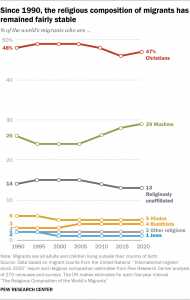Christians make up close to half the world’s 280 million migrants, followed by significant numbers of Muslims, agnostics and atheists, according to a new study by the Pew Research Center.
Released in August, “The Religious Composition of the World’s Migrants” report presents an analysis of 270 censuses and United Nations data collected through 2020, the most recent year global data are available. The study delves into changes in global migration by region and how Christian, Muslim, Hindu, Buddhist, Jewish and the religiously unaffiliated are represented in migration numbers.
 “Christians make up a much larger share of migrants (47%) than they do of the world’s population (30%). Mexico is the most common origin country for Christian migrants, and the United States is their most common destination” with Germany and Russia close behind, the report says.
“Christians make up a much larger share of migrants (47%) than they do of the world’s population (30%). Mexico is the most common origin country for Christian migrants, and the United States is their most common destination” with Germany and Russia close behind, the report says.
Muslims also comprise a greater share of migrants (29%) than they do of the world’s population (25%). The Pew report shows Syria is the most common origin country for Muslim migrants, and Muslims often move to places in the Middle East-North Africa region, such as Saudi Arabia.
The share of Jews who have migrated (1%) far exceeded Judaism’s percentage of the world population (0.2%), and their most common destination is Israel.
The report explains: “In percentage terms, this means Jews are more likely than people in the world’s other major religious groups to live outside their country of birth. Two in 10 Jews have moved across national borders as of 2020, compared with smaller shares of Christians (6%), Muslims (4%), Buddhists (2%), religiously unaffiliated people (2%) and Hindus (1%).”
On the other hand, Hindus represent 5% of migrants despite being 15% of the global population, while Buddhists make up 4% of international migrants and 4% of the world’s population. While India is the most common nation of origin and destination for Hindus, for Buddhists Myanmar is the source for most migrants and Thailand is the most frequent destination.
Agnostic, atheist and other nonreligious people make up 23% of the world’s population and 13% of its migrants, the report notes. “China is the most common origin country for religiously unaffiliated migrants, and the U.S. is their most common destination.”
 The total number, or “stock,” of international migrants increased from 153 million to 281 million from 1990 to 2020, an 83% surge compared to the 47% increase in global population. But the religious makeup of migrants remained largely stable during those three decades.
The total number, or “stock,” of international migrants increased from 153 million to 281 million from 1990 to 2020, an 83% surge compared to the 47% increase in global population. But the religious makeup of migrants remained largely stable during those three decades.
“While the religious makeup of migration flows can change drastically from year to year — due to wars, economic crises and natural disasters — the total stock of migrants changes more slowly, reflecting patterns that have accumulated over time,” the report states.
The study documents a surge in the number of Christian migrants (from 72.7 million to 130.9 million) during the 30-year period measured, while Muslim migrants increased from 39.9 million to 80.4 million. The world’s population of religiously unaffiliated migrants jumped from 21.8 million to 36.4 million and Buddhist migrants shot up from 4.6 million to 10.9 million during that period.
“However, the religious composition of the global migrant population has not changed dramatically from a few decades ago,” the report says. “This is largely because the sizes of each migrant stock were so unequal in 1990. Even though the migrant populations have grown at different rates in recent decades, their mix in 2020 still reflects the large differences in their initial sizes in 1990.”
 Among Christians, Russia (8 million) and the Philippines (5.2 million) are the second and third leading origin of Christian migrants, behind Mexico (11 million). Next in line are Ukraine (4.6 million), Venezuela (4.6 million) and Poland (4 million). Among their leading destinations are the United States (35 million), Germany (8.4 million), Russia (7 million) and the United Kingdom (5 million).
Among Christians, Russia (8 million) and the Philippines (5.2 million) are the second and third leading origin of Christian migrants, behind Mexico (11 million). Next in line are Ukraine (4.6 million), Venezuela (4.6 million) and Poland (4 million). Among their leading destinations are the United States (35 million), Germany (8.4 million), Russia (7 million) and the United Kingdom (5 million).
“Perhaps surprisingly, India is another common source of Christian migrants, with over 3 million originating from there,” the report says. “Christians are a tiny minority in India, but given the large size of the country’s population, there are tens of millions of India-born Christians. Moreover, India is one of many countries in which emigrants disproportionately come from a religious minority. Christians make up 2% of India’s population but an estimated 16% of all the people who were born in India and now reside elsewhere.”


